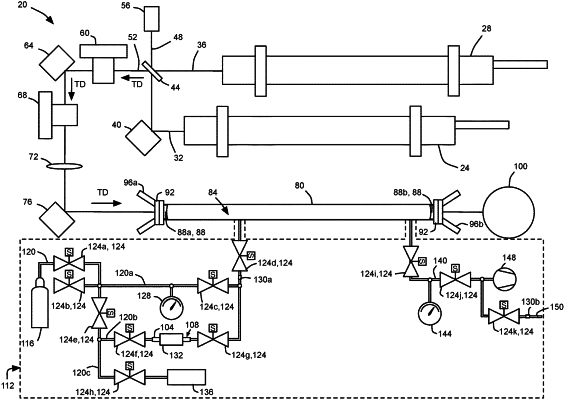| CPC G01N 21/39 (2013.01) [G01J 3/0205 (2013.01); G01J 3/10 (2013.01); G01J 3/42 (2013.01); G01N 1/40 (2013.01); G01N 21/31 (2013.01); G01N 21/3504 (2013.01); G01N 21/552 (2013.01); G01N 33/497 (2013.01); G01J 2003/423 (2013.01); G01N 2021/391 (2013.01); G01N 2021/398 (2013.01); G01N 2021/7789 (2013.01); G01N 2033/4975 (2013.01); G06N 20/00 (2019.01)] | 17 Claims |

|
1. A method for analyzing a sample using cavity ring-down spectroscopy, comprising:
desorbing a first part of a breath sample from a thermal desorption tube heated to a first desorption temperature to load the first part of the breath sample into a ring-down cavity;
for each of a first set of wavelengths:
generating, via at least one laser, a laser beam at the wavelength directed into the ring-down cavity;
extinguishing the laser beam entering the ring-down cavity; and
registering light intensity decay data for light exiting the ring-down cavity via a light intensity sensor system;
loading a second part of the sample desorbed from the thermal desorption tube heated to a second desorption temperature;
for each of a second set of wavelengths:
generating, via at least one laser, a laser beam at the wavelength directed into the ring-down cavity;
extinguishing the laser beam entering the ring-down cavity; and
registering light intensity decay data for light exiting the ring-down cavity via a light intensity sensor system; and
determining, via at least one processor, a probability from the light intensity decay data using a predictive model that is at least partially based on the dataset of light intensity decay data for the first set of wavelengths and the second set of wavelengths that a subject from which the breath sample was received has a physiological condition or a degree of a physiological condition at least indirectly using a dataset of light intensity decay data for previously analyzed breath samples for which the presence or absence of lung cancer or the degree of lung cancer has been identified.
|